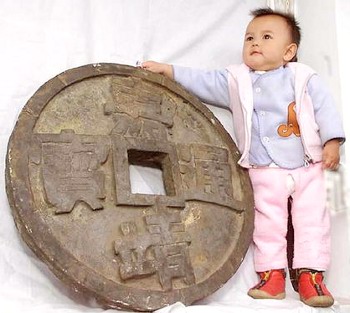The official New China News Agency (新华社) revealed in 1997 that Chinese archaeologists working in the southwestern province of Yunnan had unearthed a huge Ming Dynasty coin which was described as the largest and heaviest ancient Chinese coin ever found.

China's Largest and Heaviest Ancient Coin
The coin was cast during the reign of Emperor Shi Zong (1522-1567) to commemorate the opening of a mint in dongchuanfu (东川府) which is now known as Huize County (会泽县).
This commemorative coin (开炉钱) is now on display at the Huize County Lead and Zinc Mine Archives (会泽县的铅锌矿档案馆).
The inscription on this giant bronze cash coin reads jia jing tong bao (嘉靖通宝).
The coin has a diameter of 57.8 cm (22.8 in), a thickness of 3.7 cm (1.5 in) and a weight of 41.5 kg (91.5 lbs).
An assay in 1990 revealed that the coin is primarily composed of 91% copper, 3% lead, 0.6% zinc and 0.6% aluminum.
While the history of this region dates back more than 2,000 years, bronze cash coins did not circulate until very late. Cowrie shells were still being used as a form of money even into the Ming Dynasty (1368-1644). The economy relied to a great extent on barter. The upper class used silver for their purchases.
The casting of coins required approval from the imperial government. It was not until the jia jing period (1522-1567) when large-scale copper mining and smelting were permitted in the area. Yunnan’s rich mineral resources coupled with China’s mature casting technology were then used to produce these first bronze coins with the jia jing tong bao inscription.
Following the reign of Emperor Shi Zong, coins continued to be cast at this mint for the succeeding Ming rulers. These coins included Emperor Shen Zong’s wan li tong bao (万历通宝 1573-1620), Emperor Xi Zong’s tian qi tong bao (天启通宝 1621-1627), and Emperor Si Zong’s chong zhen tong bao (崇祯通宝 1628-1644).
Coins of the Southern Ming, including the yong li tong bao (永历通宝 1646-1659) of Prince Yongming (永明王) and the xing chao tong bao (兴朝通宝 1648-1657) of Sun Kewang (孙可望), were also cast at this mint.
With the establishment of the mint, and following the casting of the special commemorative coin, standard “cash coins” with the the same jia jing tong bao inscription were cast. Additionally, a few larger denomination coins with the jia jing tong bao inscription were produced in values equivalent to 2, 3, 5 and 10 of the smaller “cash” coins. All of these larger denomination coins are now rare.
However, even the largest “Value 10” coin, with a diameter of 4.5 cm (1.8 in), pales in comparison with the special commemorative coin made to celebrate the first use of the furnace to cast bronze coins at the new mint.